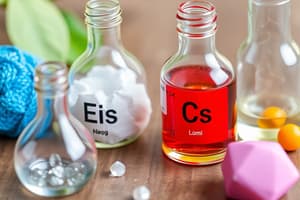Podcast
Questions and Answers
What role do properties of matter play in identifying materials?
What role do properties of matter play in identifying materials?
- They determine the price of materials.
- They are irrelevant to distinguishing between materials.
- They help categorize materials based on appearance, taste, and shape. (correct)
- They influence the temperature of the materials.
Which statement best describes the importance of understanding matter's properties?
Which statement best describes the importance of understanding matter's properties?
- It does not affect everyday life.
- It is only useful for scientific research.
- It helps prevent accidents related to confusing substances. (correct)
- It only applies to solid materials.
Which of the following properties is NOT typically used to classify matter?
Which of the following properties is NOT typically used to classify matter?
- Shape
- Size
- Smell (correct)
- Color
What could be a potential outcome of not being able to identify the properties of a harmful substance?
What could be a potential outcome of not being able to identify the properties of a harmful substance?
How might personal experiences influence one’s understanding of matter's properties?
How might personal experiences influence one’s understanding of matter's properties?
Which of the following is a characteristic of physical properties?
Which of the following is a characteristic of physical properties?
Which of the following is NOT considered a physical property?
Which of the following is NOT considered a physical property?
Which property can be used to compare a metal chair with a wooden chair?
Which property can be used to compare a metal chair with a wooden chair?
Which of the following pairs identifies two physical properties of materials?
Which of the following pairs identifies two physical properties of materials?
What does the term 'impermeability' in relation to physical properties refer to?
What does the term 'impermeability' in relation to physical properties refer to?
Which shape describes both a ball and an orange?
Which shape describes both a ball and an orange?
How does the texture of silk compare to that of sandpaper?
How does the texture of silk compare to that of sandpaper?
Which object is likely to be the largest?
Which object is likely to be the largest?
What geometric shape does a pyramid primarily resemble?
What geometric shape does a pyramid primarily resemble?
Which statement about the properties of objects is true?
Which statement about the properties of objects is true?
Which material is considered absorbent and can pass water through its pores?
Which material is considered absorbent and can pass water through its pores?
What property describes a material's ability to allow heat and electricity to flow?
What property describes a material's ability to allow heat and electricity to flow?
Which of the following materials is known for its flexibility and can be easily bent?
Which of the following materials is known for its flexibility and can be easily bent?
What is the term for a material's ability to flow and fill a space, such as when pouring water?
What is the term for a material's ability to flow and fill a space, such as when pouring water?
Which of the following is a good conductor and commonly used in electrical cables?
Which of the following is a good conductor and commonly used in electrical cables?
Which material is known for its exceptional hardness, even more so than steel?
Which material is known for its exceptional hardness, even more so than steel?
What characteristic defines a material as impermeable?
What characteristic defines a material as impermeable?
Which property of materials refers to their resistance to heat and electricity passing through?
Which property of materials refers to their resistance to heat and electricity passing through?
Which property allows metals to be attracted to magnets?
Which property allows metals to be attracted to magnets?
In the context of solubility, what term is used for the substance that dissolves another substance?
In the context of solubility, what term is used for the substance that dissolves another substance?
What is the primary property that allows metals to be separated using large magnets in junkyards?
What is the primary property that allows metals to be separated using large magnets in junkyards?
Which of the following statements about rigidity is true?
Which of the following statements about rigidity is true?
In the context of solubility, which term refers to the substance that dissolves another substance?
In the context of solubility, which term refers to the substance that dissolves another substance?
Why is water considered the universal solvent?
Why is water considered the universal solvent?
Which process is required to change the shape of a rigid material like glass?
Which process is required to change the shape of a rigid material like glass?
Which of the following materials is known for being a good conductor of heat and electricity?
Which of the following materials is known for being a good conductor of heat and electricity?
What is a primary characteristic that makes metals useful in manufacturing consumer goods?
What is a primary characteristic that makes metals useful in manufacturing consumer goods?
What does transparency in materials refer to?
What does transparency in materials refer to?
Which of the following is NOT commonly associated with useful materials?
Which of the following is NOT commonly associated with useful materials?
Which material is an example of having high strength?
Which material is an example of having high strength?
How are metals typically characterized in terms of their physical properties?
How are metals typically characterized in terms of their physical properties?
What does thickness refer to in the context of a material?
What does thickness refer to in the context of a material?
Which of the following materials is commonly used for making kitchenware?
Which of the following materials is commonly used for making kitchenware?
What best describes physical change in materials?
What best describes physical change in materials?
Which of the following statements is true regarding opaque materials?
Which of the following statements is true regarding opaque materials?
Which of the following best defines the term 'translucent'?
Which of the following best defines the term 'translucent'?
Which example best demonstrates an opaque material?
Which example best demonstrates an opaque material?
Which physical change occurs when a piece of paper is folded?
Which physical change occurs when a piece of paper is folded?
What characterizes a transparent material?
What characterizes a transparent material?
In which of the following scenarios will cutting a piece of paper alter its physical properties?
In which of the following scenarios will cutting a piece of paper alter its physical properties?
What does flammability indicate about a substance?
What does flammability indicate about a substance?
Which example demonstrates reactivity in a substance?
Which example demonstrates reactivity in a substance?
What is the outcome when wood is burned?
What is the outcome when wood is burned?
What effect does rusting have on an iron object?
What effect does rusting have on an iron object?
Which statement accurately describes a characteristic of chemical properties?
Which statement accurately describes a characteristic of chemical properties?
Flashcards are hidden until you start studying
Study Notes
Properties of Matter
- Matter is classified based on properties, which are characteristics of an object.
- Properties can be external or internal, guiding material identification.
Categories of Properties
- Two main classes of properties: Physical and Chemical.
Physical Properties
- Observable without changing composition; include characteristics such as:
- Color: Describes lightness, darkness, hue, and saturation.
- Shape: The external outline; examples include round (ball, orange) and rectangular (box, picture frame).
- Size: Dimensions of an object; comparison such as elephant vs. mouse.
- Texture: Smoothness or roughness (silk is smooth, sandpaper is rough).
- Absorbency: Ability of a material to soak up liquid (e.g., paper, cloth, cotton).
- Conductivity: Capacity to transfer heat or electricity; copper is a prime conductor.
- Flexibility: Property of bending without breaking; wires can be shaped easily.
- Fluidity: A matter's ability to flow (e.g., pouring water).
- Hardness: Resistance to deformation; titanium and diamonds exhibit high hardness.
- Impermeability: Barrier to liquid penetration; examples include plastics and metals.
- Insulation: Prevents heat/electricity flow; wool is commonly used for warmth.
- Magnetism: Attraction to magnets; metals like iron are magnetic.
- Solubility: Ability of a substance (solute) to dissolve in another (solvent); water is a universal solvent.
- Rigidity: Difficulty in bending; glass is a rigid material.
- Transparency: Light passage; transparent objects allow light, while opaque do not.
Changes in Physical Properties
- Physical Change: Alters size, shape, or appearance without changing the material's composition (e.g., cutting paper).
- Transparency Classifications:
- Opaque: No light passes through.
- Translucent: Some light passes through.
- Transparent: All light passes through.
Chemical Properties
- Concern the internal composition of matter; includes:
- Flammability: Ability of a substance to catch fire (e.g., wood).
- Reactivity: Chemical changes affecting properties; iron rusts when exposed to oxygen and moisture.
Useful vs. Harmful Materials
- Material properties help assess utility or danger.
- Useful Materials: Metals, plastics, wood, and textiles are typically strong, flexible, and conductive, making them valuable for various applications (e.g., kitchenware, vehicle parts).
Summary
- Understanding the properties of matter is crucial for distinguishing between harmless and harmful substances.
- Knowledge of physical and chemical characteristics enables safe handling and effective use of materials in everyday life.
Studying That Suits You
Use AI to generate personalized quizzes and flashcards to suit your learning preferences.




